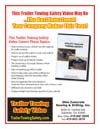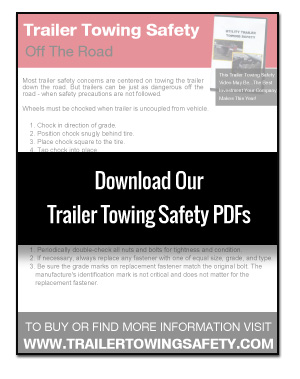|
Trailer safety begins the moment a company or individual decides to employ a trailer. Before any load is carried, equipment choices must be made. When selecting your equipment, always think ahead, with a mind towards safety. Many trailer accidents can be avoided long before the trip, simply by choosing the right equipment.
The first concern is using a tow vehicle prepared for and capable of handling the desired load. It is also important to use the proper trailer. Use gross trailer weight to select a proper towing vehicle.
*Remember: Do not modify or change the trailer in any way - changes void the warranty. Read Owner's Manual. Use only genuine factory parts as replacements.
The proper hitch is also an important choice in maintaining trailer safety. Make sure the trailer ball is the right size for your trailer tongue. A two-inch trailer receiver will fit very nicely on a 1 7/8" ball. It will also pop off when you hit a good bump.
A load distributing hitch is used for heavier trailer models. These load distributing hitches use special equipment to distribute the tongue load to all axles of the tow vehicle and trailer to help stabilize the tow vehicle. Here are some terms you should know when discussing hitch adjustment and in evaluating hitch performance:
- Receiver: Hitch platform fitted to the tow vehicle.
- Ball Mount: A removable steel component that fits into the receiver. The hitch ball and spring bars (only on load distributing hitches) are attached to it.
- Sway Control: A device designed to lessen the pivoting motion between tow vehicle and trailer when a balltype hitch is used.
- Coupler: The ball socket at the front of the trailer A-frame that receives the hitch ball.
- Spring Bars: Load-leveling bars used to distribute hitch weight among all axles of tow vehicle and trailer in a load distributing ball-type hitch.
Incorrect size or rating of hitch can cause trailer to break loose from towing vehicle. Be sure towing vehicle hitch is correct type, size, and rating to match coupler. Be sure the hitch is properly installed onto towing vehicle. On optional ball couplers, always insert hitch safety pin before towing. Make sure hitch and ball are properly sized and match each other.
The selection of a brake system also will depend on your tow vehicle and the type and fully loaded weight of your trailer. For a trailer with a loaded weight of more than 1,500 pounds, many states require a separate braking system and a breakaway switch, located on the tongue of the trailer, to activate the trailer brakes in the event the trailer separates from the tow vehicle. There are two basic types of brake systems designed to activate the brakes on a trailer:
- Electronically controlled brakes usually provide automatic and manual control for trailer brakes. They require that the tow vehicle be equipped with a controlling device and additional wiring for electrical power. These brakes typically have a control box installed within reach of the driver and can be manually or automatically applied. The control box may require adjustment or "tuning in" for variations in trailer load.
- Surge brakes are independent hydraulic brakes activated by a master cylinder at the junction of the hitch and trailer tongue. These brakes are not controlled by the hydraulic fluid in the brake system of the tow vehicle. Note: The hydraulic system of the tow vehicle should never be directly connected to the hydraulic system of the trailer. These systems are self-compensating and do not require adjustment for variation in trailer load.
Follow the tow vehicle manufacturer's recommendations for brake selection. Some states require braking systems on all axles of the trailer. So, check your state's requirements by contacting the motor vehicle administration |


